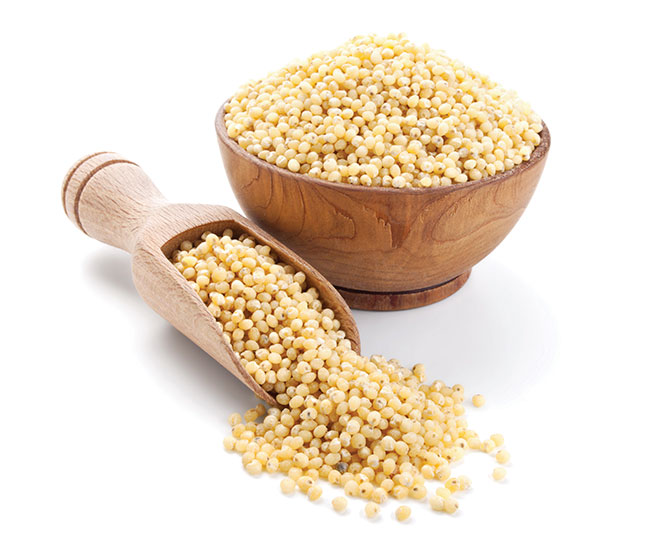
Final Proof: What’s new in flour alternatives
April 19, 2023
By
Jane Dummer
When it comes to alternative flours, millet, fava and lupin flours are on trend
 PHOTO: andriigorulko / Adobe Stock
PHOTO: andriigorulko / Adobe Stock The alternative wheat flour category is growing. Ingredient suppliers, millers and commodity groups are savvier at understanding their flours’ different compositions. As a result, they know how each reacts with the other ingredients in baking formulations. While wheat flour is one of the world’s most important staples, recent global events, along with consumer demand for alternative flours, plus the nutrition benefits and rising interest in sustainability, have created the opportunity for various substitutions. With gluten-free and allergy-free cereal grains like sorghum and millet, pulses including chickpeas and fava beans, and legumes such as lupins, along with seed blends, there are several options available to the baking industry.
A spotlight has been shone on millet this year. The United Nations General Assembly declared 2023 the International Year of Millets. John Manuel, vice-president of sales for Healthy Food Ingredients in Fargo, N.D., explains: “Though millet includes many cultivated species from different branches of the grass family, typically in the North American food industry, we’re referring specifically to proso millet. Millet uses up to 50 per cent less water during the growing season versus other crops. Also, millet requires much less nitrogen than other crops, decreasing the need for inputs and reducing its carbon footprint.”
Millet flour adds nutrients including protein, fibre and essential minerals like phosphorus. Manuel says, “Millet flour is optimal for a variety of gluten-free baking applications, performing similarly to other gluten-free flours. It has a mild, yellow colour, neutral appearance and naturally nutty flavour. A Bay Area restaurant is using millet in porridge bread – a great example of the unique flavour millet provides. Also, there are many small bakeries making millet breads. Retail brands are using millet in pressed bars, granolas and cereals. Our micro-reduction process, IntegriPure®, provides a ready-to-eat product in which millet can be utilized as a bread topping and as an allergen-friendly replacement for nuts to add crunch in confections. Millet has significant growth as an allergen-free nut alternative to provide a crunch to baked goods.”
Whole pulse seeds can be milled into whole pulse flour similar to whole-wheat and whole-grain flours. Hailey Jefferies, president of Prairie Fava in Manitoba, explains: “Fava beans fix more nitrogen than any other pulse crop, reducing the need for industrial nitrogen-based fertilizers which improves soil health. Fava beans also require few inputs, withstand drought and frost in north temperate ecosystems. This means higher net returns for farmers and fewer greenhouse gas emissions. Fava flour is high in protein, high in fibre and low in fat. And with its light, non-beany flavour and neutral colour, it’s an ideal ingredient for baked products. Its neutral pH lends well for fermented bakery applications. It has excellent emulsification and foaming properties, thus improving crumb structure and reducing the need for gums in baked applications. In retail, fava flour is the first ingredient in Flourish Pancakes, a high-protein pancake mix. Also, Queen Street Bakery uses fava flour in a variety of their gluten-free breads, buns and bagels.”
Sweet lupin is a new commercial crop to North America, offering economic, environmental and health benefits. Tristan Choi, founder and chief executive officer of Lupin Platform Inc. in Calgary, says: “Lupin is a nitrogen-fixing legume, which can be used in crop rotations to reduce chemical nitrogen fertilizers. Legumes produce the lowest CO2 per 100 grams of protein compared to soybeans and animal proteins. Lupin flour has three times the protein of oats, three times the dietary fibre of quinoa plus antioxidants, potassium and iron. Its light golden colour and neutral, nutty, slightly toasted taste is perfect for various applications including biscuits, muffins and cookies. Lupin flour absorbs liquid well and gels without the addition of thickening agents. It has a fine texture, much lighter than that of other gluten-free flours. It blends well with gluten-free, low-carb ingredients targeting the keto-friendly audience. Additionally, it can be blended with regular wheat flour for protein and dietary fibre-enriched baking needs.”
Mark Pickard, president of InfraReady Products in Saskatoon, concludes: “The good we get from grain is not limited to wheat, as recognizable consumer and societal benefits can be derived from alternative whole-grain ingredients. While wheat flour is an important global stable, other cereals and pulses continue to increase their participation in baking for consumer interest, nutritional improvements and practical opportunity.”
Jane Dummer, RD, known as the Pod to Plate Food Consultant, collaborates and partners with the food and nutrition industry across North America. janedummer.com
Print this page
Leave a Reply